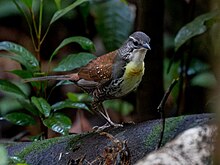| Rusty-belted tapaculo | |
|---|---|

| |
| Liosceles thoracicus thoracicus, Pará, Brazil | |
| Conservation status | |
 Least Concern (IUCN 3.1) | |
| Scientific classification | |
| Domain: | Eukaryota |
| Kingdom: | Animalia |
| Phylum: | Chordata |
| Class: | Aves |
| Order: | Passeriformes |
| Family: | Rhinocryptidae |
| Genus: | Liosceles P.L. Sclater, 1865 |
| Species: | L. thoracicus |
| Binomial name | |
| Liosceles thoracicus (P.L. Sclater, 1865) | |

| |
| Synonyms | |
|
Pteroptochus thoracicus P. L. Sclater, 1865 | |
The rusty-belted tapaculo (Liosceles thoracicus) is a species of suboscine passerine bird in the tapaculo family Rhinocryptidae. It is the only species placed in the genus Liosceles. It is found in Brazil, Bolivia, Colombia, Ecuador, and Peru.
Taxonomy
The rusty-belted tapaculo is the only species in its genus; the genus and species were first described by Philip Lutley Sclater in 1865. Three subspecies are recognized: the nominate Liosceles thoracicus thoracicus, L. t. dugandi, and L. t. erithacus.
The rusty-belted tapaculo is genetically most closely related to the spotted bamboowren (Psilorhamphus guttatus).
Description
The rusty-belted tapaculo is 19.5 cm (7.7 in) long and weighs 39 to 42 g (1.4 to 1.5 oz). Its plumage is unlike that of any other tapaculo. The nominate subspecies has a grayish brown head with a white supercilium and a reddish brown back, wings, and rump. The throat is white with black streaks at the side, most of the breast is white, and the flanks and vent are barred with black, brown, and white. The upper breast has a yellow to orange brown band the gives the species its common name. Subspecies L. t. erithacus is browner on the head and the breast band is larger and darker. Subspecies L. t. dugandi is also similar to the nominate, but the breast band is rufous and extends into the neck and throat.
The rusty-belted tapaculo vocalizes from the ground or low branches. Its song is an "easily imitated whistled note...repeated at intervals... descending series" . Its call is described as a repeated cree or "cree-cree".
Distribution and habitat
The nominate subspecies of the rusty-belted tapaculo is found in west and central Amazonian Brazil, and is believed to be the race found in southeastern Peru and northern Bolivia. Subspecies L. t. dugandi inhabits southeastern Colombia and adjacent western Brazil. Subspecies L. t. erithacus is found in eastern Ecuador and eastern Peru.
The rusty-belted tapaculo is the only member of its family to inhabit the Amazonian rainforest. It is primarily found in humid terra firme forest, whose ground is dry year-round, but also inhabits várzea, which is seasonally flooded. It ranges generally up to 600 m (2,000 ft) elevation, in some places to 900 m (3,000 ft), and in Peru up to 1,000 m (3,300 ft).
Behavior
Feeding
The rusty-belted tapaculo's primary prey is terrestrial true bugs, Hemiptera. It forages by walking and hopping on the forest floor, picking the bugs from atop the litter, and also feeds along fallen tree trunks.
Breeding
Very little is known about the rusty-belted tapaculo's breeding phenology. Only one nest has been found; it was spherical, made of twigs, grass, and other materials, and on the ground among the roots of a small tree.
Status
The IUCN has assessed the rusty-belted tapaculo as being of Least Concern. Its population, though of unknown size, is believed to be fairly large and stable. It is found in several large protected areas.
References
- ^ BirdLife International (2016). "Liosceles thoracicus". IUCN Red List of Threatened Species. 2016: e.T22703446A93923514. doi:10.2305/IUCN.UK.2016-3.RLTS.T22703446A93923514.en. Retrieved 15 November 2021.
- ^ Krabbe, N. and T. S. Schulenberg (2020). Rusty-belted Tapaculo (Liosceles thoracicus), version 1.0. In Birds of the World (J. del Hoyo, A. Elliott, J. Sargatal, D. A. Christie, and E. de Juana, Editors). Cornell Lab of Ornithology, Ithaca, NY, USA. https://doi.org/10.2173/bow.rubtap1.01 retrieved April 26, 2021
- Remsen, J. V., Jr., J. I. Areta, E. Bonaccorso, S. Claramunt, A. Jaramillo, D. F. Lane, J. F. Pacheco, M. B. Robbins, F. G. Stiles, and K. J. Zimmer. Version 19 January 2021. A classification of the bird species of South America. American Ornithological Society. http://www.museum.lsu.edu/~Remsen/SACCBaseline.htm retrieved January 19, 2021
- "ITIS Report: Liosceles". BirdLife International. Retrieved 26 April 2021.
- Harvey, M.G.; et al. (2020). "The evolution of a tropical biodiversity hotspot". Science. 370 (6522): 1343–1348. Bibcode:2020Sci...370.1343H. doi:10.1126/science.aaz6970. hdl:10138/329703. PMID 33303617. A high resolution version of the phylogenetic tree in Figure 1 is available from the first author's website here.
External links
- Rusty-belted tapaculo videos on the Internet Bird Collection
- Image at ADW
| Taxon identifiers | |
|---|---|
| Liosceles thoracicus |
|
